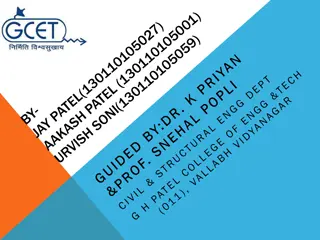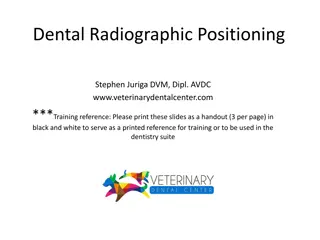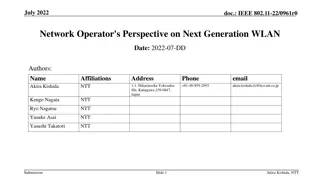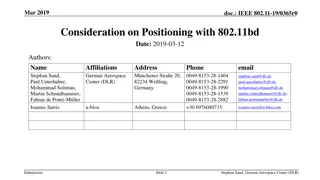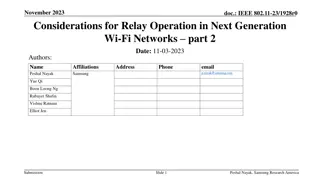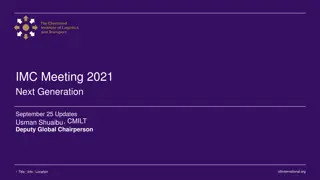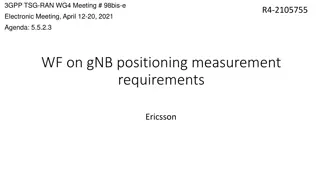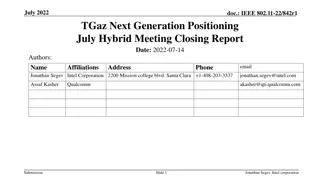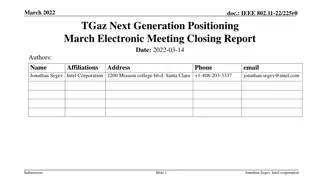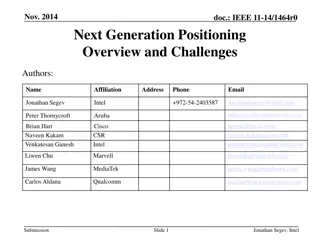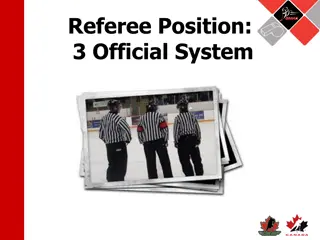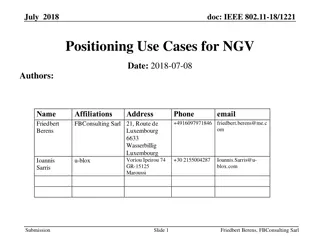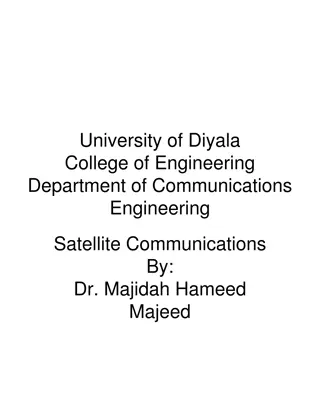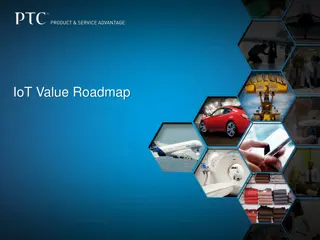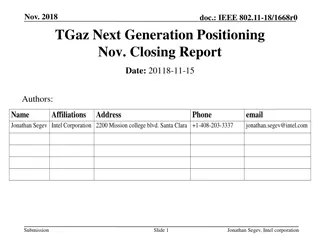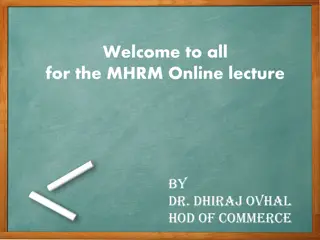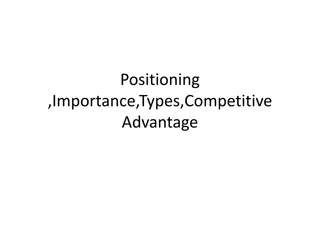Next Generation Positioning Use Cases and Requirements
This document outlines selected use cases for next-generation positioning (NGP) in the context of IEEE 802.11. It covers scenarios such as positioning for home audio systems and navigation in public buildings utilizing WLAN technology. Detailed positioning requirements for different use cases, including accuracy, latency, and refresh rates, are provided to support the development of NGP solutions in smart home and public environments.
Download Presentation

Please find below an Image/Link to download the presentation.
The content on the website is provided AS IS for your information and personal use only. It may not be sold, licensed, or shared on other websites without obtaining consent from the author.If you encounter any issues during the download, it is possible that the publisher has removed the file from their server.
You are allowed to download the files provided on this website for personal or commercial use, subject to the condition that they are used lawfully. All files are the property of their respective owners.
The content on the website is provided AS IS for your information and personal use only. It may not be sold, licensed, or shared on other websites without obtaining consent from the author.
E N D
Presentation Transcript
May 2015 doc.: IEEE 802.11-15/0561r0 Selected use cases for next generation positioning Date: 2015/05/XX Authors: Name Affiliations Address Phone +49-711- 5858236 email thomas.handte@ eu.sony.com daniel.schneider@ eu.sony.com Thomas Handte Sony Deutschland GmbH Hedelfinger Str. 61, D-70327 Stuttgart Daniel Schneider Submission Slide 1 Thomas Handte, Sony
May 2015 doc.: IEEE 802.11-15/0561r0 Abstract This document provides several use cases for next generation positioning (NGP) The use cases are supported with estimates on required accuracy latency refresh rate number of simultaneous users (within AP coverage) The terminology is as 11-15/0388r0 defined in document Submission Slide 2 Thomas Handte, Sony
May 2015 doc.: IEEE 802.11-15/0561r0 1. Positioning for Home Audio Background: Advanced audio formats with immersive sound experience require exact position estimates of listener and speakers User: Person with WLAN based home audio system WLAN is employed for both sound transfer and positioning Environment: Smart home with 802.11 coverage. 1 AP per floor supporting .11n, .11ac, and NGP 1 AP in close vicinity supporting .11ad, .11ay, and NGP Optional: multiple APs from neighboring apartments Use case speaker system calibration 1. The user installs his home audio system including various WLAN speakers 2. The speaker placement and position is automatically determined 3. The home audio system adjusts the speaker settings for best sound experience Use case follow-me sound 1. The user has a wearable WLAN device 2. The device s position is continuously monitored 3. The home audio system adjusts the speaker settings according to the user s position and movement for immersive sound experience 4. In a simple case, the sound may only follow in neighboring rooms A. B. Submission Slide 3 Thomas Handte, Sony
May 2015 doc.: IEEE 802.11-15/0561r0 1. Positioning for Home Audio (cont.) Positioning requirements Use case follow-me sound speaker system calibration same room (simple) < 50cm (typ.) < 10cm (high fidelity) 1 same floor < 50cm (typ.) 1 Horizontal accuracy < 10cm not required Vertical accuracy < 10cm (high fidelity) < 10cm (high fidelity) 1 Latency < 10ms < 10ms Refresh rate > 2 > 10 locations/s (depending on accuracy) < 0.1 locations/s The user may accept further APs for high fidelity 1) orientation between wearable device and ear must be known (e.g. smart eyeglasses) Submission Slide 4 Thomas Handte, Sony
May 2015 doc.: IEEE 802.11-15/0561r0 2. Navigation in public buildings User: Person with smartphone, smart wear, smart eyeglasses with navigation app Environment: Public building with 802.11 coverage. The expected AP environment is 1 AP per < 200 users or < 400m / 4000 sq. ft. APs support .11n, .11ac, .11ax, and NGP Use case 1. The user enters a public building like stadium, concert hall, airport, museum, fair, parking deck 2. The smart device navigates the user to a particular seat, gate, point of interest, contact person, or empty parking lot Submission Slide 5 Thomas Handte, Sony
May 2015 doc.: IEEE 802.11-15/0561r0 2. Navigation in public buildings (cont.) Positioning requirements: Horizontal accuracy: < 1m Vertical accuracy: same floor/tier Latency: < 250ms Refresh rate: > 1 locations/s Expected number of simultaneous users: < 1000 (within AP coverage area) Submission Slide 6 Thomas Handte, Sony
May 2015 doc.: IEEE 802.11-15/0561r0 References Cisco Systems Inc., 11-15-0388-00-0ngp NGP Use Case Template Jonathan Segev, Intel, 11-14-1464-02-0wng NG Positioning Overview and Challenges Submission Slide 7 Thomas Handte, Sony
May 2015 doc.: IEEE 802.11-15/0561r0 BACKUP Submission Slide 8 Thomas Handte, Sony
Santosh Pandey, Cisco doc.: IEEE 802.11-15/0561r0 Terminology of doc. 11-15/0388r0 User The end entity (human) who would use this technology Use case A use case is task oriented. It describes the specific step by step actions performed by a user or device. One use case example is a user starting and stopping a video stream. Environment The type of place in which a network is deployed, such as home, outdoor, hot spot, enterprise, metropolitan area, etc. Frequency bands of interest (FBoI): The 802.11 operating frequency bands relevant to this use case. Eg. for a shopping mall s enterprise wireless it will be 2.4GHz and 5GHz AP density: Density of AP deployment, e.g. APs deployed every 4000 sq.ft. AP height: Height, above the floor, at which the APs are deployed, e.g. for shopping mall APs deployed approximately 15-25 ft above the floor Key Location Requirement- Expected Horizontal Accuracy: XY accuracy expected for the use case to succeed, <1m@90% is a requirement is that the computed location be within 1m horizontally of the actual location 90% of the time Expected Vertical Accuracy: Z accuracy expected for the use case to succeed, same floor@99% is a requirement is that the computed location be on the same floor as the actual location 99% of the time. 0.5m@90% is a requirement is that the computed location be within 0.5m vertically of the actual location 90% of the time Expected Latency: Expected time taken to complete a single atomic location process. The location process begins with initiating a location request, then computing location, and ends with returning the computed location. E.g. 10 ms latency would indicate that it takes 10 ms after the request is transmitted to gather measurements, compute a location, and transfer any parameters such that the requester has a location within 10 ms. Expected Refresh Rate: This defines how frequently is the computation expected when client moving. E.g. a refresh rate of 10 locations per second would indicate that location needs to be refreshed 10 times in a second Expected number of simultaneous users Submission Slide 9


